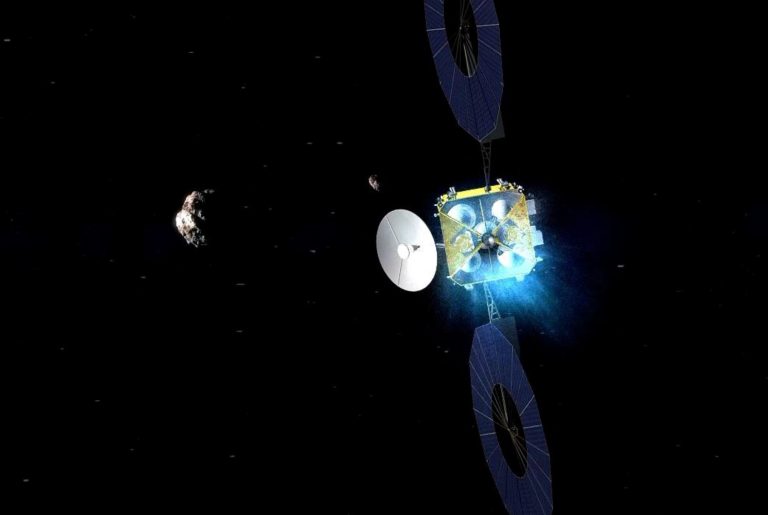HELSINKI — China is set to launch its second Tianwen deep space exploration mission late May, targeting both a near Earth asteroid and a main belt comet.
The Tianwen-2 spacecraft is now being integrated with a Long March 3B rocket at the Xichang Satellite Launch Center in southwest China, the China Aerospace Science and Technology Corporation (CASC) announced May 18, stating launch is scheduled for the end of May.
Airspace closure notices indicate a four-hour-long launch window opening at 12:00 p.m. Eastern (1600-2000 UTC) May 28. Backup launch windows are scheduled for May 29 and 30.
Tianwen-2’s first goal is to collect samples from near-Earth asteroid 469219 Kamoʻoalewa (2016 HO3) and deliver these to Earth around late 2027. A reentry module containing the samples will be released for atmospheric entry, descent and landing, but the main Tianwen-2 spacecraft will use the Earth’s gravity for a swingby, setting it on course for a six-year-voyage to comet 311P/PANSTARRS.
The mission aims to advance China’s planetary exploration capabilities, provide new insights into the understanding of small planetary bodies and their evolutions, and potentially for planetary defense and the origins of life.
Sampling Kamoʻoalewa
The roughly 40 to 100-meter-diameter asteroid is considered a quasi-satellite of Earth due to its co-orbital dynamics. Kamoʻoalewa is possibly a piece of the moon blasted into space following an impact event, according to researchers, based on spectral analyses. Analysis of the samples aims to reveal the nature and origin of the asteroid, analyze its mineral content and provide comparisons with other asteroids.
The spacecraft will attempt up to three methods of sampling: hover sampling, collecting samples with a robotic arm while matching the asteroid’s rotation; touch-and-go (TAG), using a rotating brush head; and anchored sampling, in which landing legs would use drills at the end of landing legs to press into the asteroid, if the surface composition and terrain allow. The TAG approach was used by both NASA’s OSIRIS-REx and JAXA’s Hayabusa2.
China has not released official detailed plans for the mission, such as mission timelines, the amount of samples to be collected, nor an image of the actual spacecraft. Early proposals for the mission, then named Zheng He for the Chinese admiral and explorer born in the 14th Century, indicated the spacecraft would aim to collect between 200 and 1,000 grams of samples. Renders suggest the spacecraft will feature solar panels similar in shape to NASA’s Lucy spacecraft.
While China has conducted two successful lunar sample return missions, the velocity of the reentry module will be greater for Tianwen-2, marking China’s first second-cosmic-velocity atmospheric reentry, at 12 kilometers per second, adding new challenges. CASC conducted high-altitude parachute deployment tests for the mission in 2023. In contrast to the lunar sampling missions, Kamoʻoalewa will have negligible gravity, requiring different approaches for orbiting, approaching and sampling.
China’s first excursion to an asteroid was a flyby of 4179 Toutatis in 2012, when the Chang’e-2 lunar orbiter made the pass as an extended mission objective.
Comet followup
The comet aspect of the mission will also be a test in terms of longevity of the spacecraft. 311P/PANSTARRS is seen as an ideal target for studying transitional objects between asteroids and comets, orbiting between 1.94 and 2.44 astronomical units from the Sun.
Tianwen-2 will conduct remote sensing of the comet to characterize its orbit, shape, and rotation, examine its surface composition and volatile elements, and investigate dust emissions and activity mechanisms to understand cometary behavior in the main belt.
It carries multispectral and infrared spectrometers to study surface composition, while high-resolution cameras will map geological features. A radar sounder will probe subsurface structures, and a magnetometer will search for residual magnetic fields. Dust and gas analyzers will examine comet activity, and charged particle detectors will investigate solar wind interactions. The Space Research Institute of the Russian Academy of Sciences is understood to have contributed to the particle detectors.
The mission is the second in the Tianwen (meaning “Heavenly Questions” or “Questions to Heaven”) exploration series. The first, Tianwen-1, included a Mars orbiter and surface rover, named Zhurong. The mission was a gateway to Tianwen-3, a pioneering Mars sample return mission set to launch in late 2028.
Tianwen-4 will launch around 2030. It will include a solar-powered Jupiter orbiter which will observe the system and then enter orbit around the moon Callisto—potentially including a lander—and a smaller, radioisotope-powered spacecraft to make a flyby of Uranus.The missions are also part of a wider, planetary exploration roadmap focused on astrobiology and habitability, and a long-term plan for space science.

